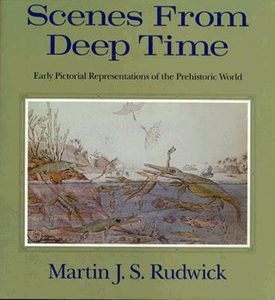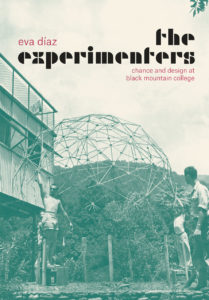Classic Series
Caroline Winterer on Martin Rudwick’s Scenes from Deep Time: Early Pictorial Representations of the Prehistoric World (Chicago University Press, 1992)
Martin Rudwick’s Scenes from Deep Time is not a classic of American intellectual history. It’s not particularly about America. It may or may not be intellectual history. But it has profoundly shaped my thinking over the last two decades about the need to incorporate material culture into the history of ideas. It’s a classic to me.
I first encountered Scenes from Deep Time in the summer of 1992, which I spent reading for my history Ph.D. exams in the UGLI at the University of Michigan. UGLI stood for undergraduate library, but the UGLI was also ugly, mid-century architecture brutaliste since given a pleasing facelift.
My memory of that summer was of drowning in a sea of words. Words about American and medieval European history, as though everything that had been felt, said, seen, done, and believed could be whittled to words. Don’t get me wrong. These were wonderful books, many beautifully written. But there were hardly any pictures or images of anything—furniture, maps, paintings, shoes, clothing. To my eyes, there was no there there. Yet from where I sat in the UGLI, the “thereness” of the ugly little library constantly shaped my experience. Fluorescent lights buzzed from the low acoustic tile ceiling. Beige industrial carpet stretched to the horizon. Even the air seemed beige in this modernist box.
And then one afternoon, there was a there there: Rudwick’s Scenes from Deep Time, a whole book about the first pictures of dinosaurs created in the nineteenth century (when the words “dinosaur” and “prehistoric” were invented). Each day, as a break from my orals  reading, I allowed myself to wander to the UGLI’s shelf of new acquisitions. I pulled out the green book with the funny shape. It was more square than rectangular, the better to see what Rudwick wanted us to see. Here was a book that took the physical world seriously. Rudwick wondered: By what act of extravagant imagination had early Victorians first summoned a lost world from many millions of years ago? Here was a world of colossal animals no human had ever seen alive, now lovingly sketched and colored as though they were just now stomping through the backyard.
reading, I allowed myself to wander to the UGLI’s shelf of new acquisitions. I pulled out the green book with the funny shape. It was more square than rectangular, the better to see what Rudwick wanted us to see. Here was a book that took the physical world seriously. Rudwick wondered: By what act of extravagant imagination had early Victorians first summoned a lost world from many millions of years ago? Here was a world of colossal animals no human had ever seen alive, now lovingly sketched and colored as though they were just now stomping through the backyard.
What I loved about Scenes from Deep Time then and continue to love now is that the pictures weren’t just illustrations of a truth already established by the text. They were the argument. But this wasn’t “art history.” As Rudwick—a paleontologist by training—made clear, art historians didn’t think much of dinosaur pictures. Real art was about Serious Things: landscape, civilization, God. Dinosaurs were just dinosaurs, minding their own terrible business. To this day, you won’t find dinosaur pictures in art museums.
Undaunted, Rudwick showed that these first dinosaur pictures were full of meaning. Not only were they about God, landscape, and civilization, they asked us to change our perspective, the way we looked at the world.
The genius moment in Scenes
is on page 47. Here Rudwick describes Henri De la Beche’s watercolor of a lagoon in prehistoric Dorset, made in 1830. A riot of dinosaurs crowds the scene, swooping through the air, creeping along the shore, chomping on each other underwater: https://en.wikipedia.org/wiki/Duria_Antiquior#/media/File:Duria_Antiquior.jpg]
Here is Rudwick’s description of the scene: “The most intriguing innovation in De la Beche’s design can easily be missed, because it is so familiar to modern eyes. The observer is not out on land, but half in the water, close to the surface and seeing the view both underwater and above it…. The viewpoint is as much that of the marine animals themselves as of any ordinary human observer.”
Why this innovation, the viewpoint half above water, and half below, half the ichthyosaur’s view, half ours? Seeing above and below water at the same time is deeply unnatural, as any swimmer knows. You can’t without great pain open your eyes just at the waterline. Rudwick speculates: maybe De la Beche was inspired by the first diving devices built to salvage underwater wrecks, which allowed people protected by a pane of glass in their helmet to comfortably look above and below water. The first home aquariums came to Victorian parlors a few years later, tiny amphibious worlds that let people see above and below the water at the same time.
I call this the aquarial view: seeing above and below the water at the same time, even though you almost never do this in real life. To me, the aquarial view is a metaphor for a disposition of mind, an openness to the new ideas suggested by new vantage points.
The aquarial view is also a manifesto. We should take visual information seriously. It is not a gewgaw glued to the load-bearing wall of the text. We should ask what the whole world of our time period contains within it. And ask ourselves if that world of things fundamentally alters the world of words that is the natural habitat of the historian.
Other books besides Rudwick’s have become classics to me because they suggest new ways of thinking about how texts and objects talk to each other. In Painting and Experience in Fifteenth-Century Italy (1972), Michael Baxandall tried looking at Renaissance paintings the way people in the Renaissance looked at Renaissance paintings. Instead of swooning over the transcendent beauty of the treasures we’ve ripped from crumbling palazzos and hung in our museums, he did the paintings the favor of learning about the world that made them. “Paintings are among other things fossils of economic life,” Baxandall wrote (2). Like the ancient lagoon of Dorset, the Renaissance was crawling with patrons, clients, painters and their messy, often selfish motives. Perhaps Baxandall’s Renaissance—an ancient ecosystem alive with chomping creatures—belongs in the natural history museum, with Rudwick’s dinosaur paintings.
Francis Haskell’s History and Its Images: Art and the Interpretation of the Past (1993) reminds us that imagery has always befuddled its interpreters. In the Renaissance, people thought every scrap of material evidence from ancient Greece and Rome must refer to some event already known from a classical text. The text was master, the image the slave. An event was an event because it was recorded in a text. But slowly over the early modern period, images broke free of their prison of text-based historical events. They took on a life of their own. Scholars confronted the disturbing possibility that an image might depict a person or event for which no written record existed. Like the tree falling in the forest with no one to hear it, the event seemed to lose its event-ness without a text. Could an event still be an event if no one had written about it, but only drawn a picture?
The one percenters of Ming China are the subject of Craig Clunas’s Superfluous Things: Material Culture and Social Status in Early Modern China (1991). Ming aristocrats loved buying pricey baubles, like vases and calligraphy. Like wine snobs today, Ming scholars invented a whole new genre of writing to talk about these useless things. They declared that their value lay in the ineffable ether of “taste.” Clunas refuses to take this new genre of writing as an objective description of these luxury objects. They are not a clue for what Ming scholars “really thought” about Ming bling. Instead, Clunas sees that this literature of objects soothed elite anxieties about their shaky social status. Only the Ming bon ton could talk about precious objects the right way, the tasteful way. As in Baxandall’s Renaissance, writing and texts talk to each other in Clunas’s Ming China. They form a total world.
For the American scene, what have become classics for me have all contained a nugget idea that constantly reminds me to think of things and not just texts. Julie Wosk’s Breaking Frame: Technology and the Visual Arts in the Nineteenth Century (1993) showed that scary new Victorian technologies were made less scary by wrapping them in comforting, familiar bubble wrap. So nineteenth-century steam engine pillars were cast in the shape of ancient Greek columns. Susan Stewart’s On Longing: Narratives of the Miniature, the Gigantic, the Souvenir, the Collection (1992) used miniature books to show that things that are too small call attention to themselves, thereby becoming big. Marcus Wood’s Blind Memory: Visual Representations of Slavery in England and America, 1780-1865 (2000) argued that since abolitionism was propaganda, all of its images reflected its political and moral agenda. The lesson: handle all imagery about slaves and slavery from the abolitionist era with care.
New books continue to surprise and intrigue us. Check out Eva Diaz’s terrific new book, The Experimenters: Chance and Design at Black Mountain College (2015), a glimpse of the artistic modernists at Black Mountain College, nestled in a pocket of Appalachia. Here  faculty-artists like Josef Albers, John Cage, and Buckminster Fuller experimented with one of the core ideas of their age: the experiment. If you define an experiment as a test of tradition that opens the door to a fresh outcome, then the experiment is also a brief for modernism, which broke away from the past to experiment with the vertiginously new. For the Black Mountain group, art wasn’t art because it was beautiful or creative. It was art because it woke us from our perceptual slumbers and prodded us to improve the world.
faculty-artists like Josef Albers, John Cage, and Buckminster Fuller experimented with one of the core ideas of their age: the experiment. If you define an experiment as a test of tradition that opens the door to a fresh outcome, then the experiment is also a brief for modernism, which broke away from the past to experiment with the vertiginously new. For the Black Mountain group, art wasn’t art because it was beautiful or creative. It was art because it woke us from our perceptual slumbers and prodded us to improve the world.
In a playful move, the main title of Diaz’s book is set in the earnestly illegible font Albers invented to save the world. The font built an alphabet from just ten basic shapes—half-moons, rectangles, and other tidbits. The typeface literally demonstrated how our kaleidoscope of perceptions is built from a few basic pieces, like Lego (a company also founded in the postwar era, whose name derives from the Danish phrase, “play well”).
The aquarial view isn’t just for historians. Henry David Thoreau said as much in his essay Walking a century and a half ago. A prophet of environmentalism, Thoreau said we should “lay our eye level with the smallest leaf, and take an insect view of its plain.” If we saw nature as the ants and bees saw it, we might think differently about our own place in nature. The aquarial view, the insect view: both help us to rearrange our mental Legos. Maybe we could not only play well, but play better.
Caroline Winterer is Anthony P. Meier Family Professor in the Humanities at Stanford University and Director of the Stanford Humanities Center. She is the author of four books, including most recently American Enlightenments: Pursuing Happiness in the Age of Reason (New Haven: Yale University Press, 2016).


0